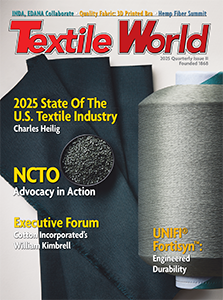REINACH, Switzerland — April 12, 2017 — Archroma will present at China Interdye 2017 some of its most innovative technologies under the motto: “Colors enhanced, performance enhanced, sustainability enhanced”. True to its long-term commitment to sustainability and innovation, Archroma will present solutions that combine performance, cost optimization and responsible textile production. With a heritage of more than 120 years, Archroma is in the position to offer solutions for enhancing colors, performance and sustainability globally.
Colors Enhanced
Drawing on its extensive formulation and technical know-how in dyestuff and pigments, Archroma will showcase at China Interdye some of its latest innovations:
Optisul® C dyes – Optisul C dyes for casualwear enable manufacturers to expand their color horizons with a new range of six dyes especially designed to produce colors in continuous dyeing processes, as well as on coating and printing. These affinity-free, sulfide-free(1) dyes, suitable for GOTS(2) and bluesign®(3) approval, can be combined with each other to obtain collections of garments suitable for wash-down treatments in a wide array of easily achievable and reproducible soft colors.
Advanced Denim technology – When employing Archroma’s ADVANCED DENIM technology, based on “Denim-Ox” and “Pad/Sizing-Ox” dyeing processes, users can reduce water consumption and wastewater by up to 92 percent, eliminate up to 63 percent of the usual cotton waste, and save up to 30 percent in energy costs compared to traditional Indigo processes. Archroma estimates that the use of this technology allowed savings of about 700 million liters of water in 2012 alone. Just imagine how much water could be used if more manufacturers would join the Advanced Denim revolution.
Metal-free acid dyes – Archroma has introduced a wide range of Nylosan® S and Lanasyn® F metal-free(1) dyes aimed at meeting the wet and light fastness levels typically needed for the creation of bright and beautiful colors on polyamide and wool, without compromising on ecological requirements. The Nylosan S dyes exhibit excellent build properties on polyamide, polyamide microfiber, polyamide/elastomeric blends, polyamide/cotton blends and on wool.
The range also incorporates AOX and metal-free(1) ternary elements including Nylosan® Orange S-3R, Nylosan Red S-3B, Nylosan Navy S-3G and Nylosan Blue-black S-3R which achieve exceptionally high wet fastness levels in deep, muted shades including navy, dark brown, olive and blacks. Nylosan Brilliant Red S-3R is also AOX and metal-free(1) and produces deep, vibrant red shades with very high wet fastness levels. As well as being metal-free(1), the Nylosan S range also meets Oeko-Tex(4) 100 and is bluesign®(3) approved.
Performance Enhanced
By offering a constant flow of eco-advanced and innovative new process and functional chemicals, Archroma provides solutions that combine performance, safety and low impact on resources.
‘Zero add-on’ formaldehyde solution for finishing – Fixapret® Resin WFF is a novel, “zero add-on” formaldehyde finishing system for no-iron performance. Its anti-wrinkle finish shows good performance and benefits compared to other such offerings, including strong, flexi Resin WFF, consumers can enjoy end-products that look good, while saving on precious resources and being gentler on the skin.
SmartRepel® Hydro – SmartRepel® Hydro supports the increasing adoption of eco-advanced materials and production processes by textile producers and brand owners. This new range is Archroma’s nature-friendlier protection that keeps cotton, polyester and polyamide textiles dry. The unique technology offers exceptional, durable water repellency and is not based on fluorine. SmartRepel Hydro produces a soft hand feel and outstanding breathability – the perfect long-lasting, high-performance finish for weatherproof garments.
EarthColors – This new range of dyes is created from agricultural waste: almond shells, saw palmetto, rosemary leaves, etc. They can be used to provide rich red, brown and green colors to denim and casualwear. The information about the individual batches of color and the garments production route is available to brand owners to be put on hang tags to be attached to each item of clothing and accessed using Near Field Communications (NFC), a sophisticated and consumer friendly technology incorporated into smartphones. With EarthColors, Archroma helps brand owners and textile mills by letting the consumer know how the colors of their clothes are made, and where the raw materials come from.
Sustainability Enhanced
For all of us, inner beauty matters just as much as outer beauty. Brand owners and retailers around the world are taking action to evaluate the environmental impact of textile treatment, dyeing and finishing processes in response to consumer concerns.
Archroma’s engagement in favor of a more sustainable textile industry is deeply rooted in everything it does. In 2012, after more than two years of development, the company launched a game-changing service called ONE WAY. ONE WAY is designed to demonstrate to textile manufacturers, brands and retailers that it is possible to bring together the dual objectives of ecology and economy. The tool provides a fast, measurable and reliable approach to the selection of chemical product and resource-saving process solutions.
We are constantly improving this tool. In 2014, Archroma added its portfolio of ZDHC MRSL-compliant(5) chemicals and dyes to the ONE WAY sustainability calculation tool. ONE WAY has received industry recognition with the 2013 ICIS Best Business Innovation Award(6).
“At Archroma,” notes Robert Liu, Head of Textile Sales & Marketing China, at Archroma: “we continuously challenge the status quo in the deep belief that we can make our industry sustainable, and we do this using the strong foundation of an expertise built over more than 120 years. We are very excited to meet customers, brands, retailers and consumers in Shanghai, and show them how Archroma can support them in the needs and challenges they face on their own markets.”
Visit Archroma on Stand A 100 at China Interdye 2017 at the Shanghai World Expo Exhibition & Convention Center from April 12-14.
Optisul®, bluesign®, Nylosan®, Lanasyn®, Fixapret® and SmartRepel® Registered trademarks.
Posted April 12, 2017
Source: Archroma




